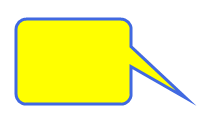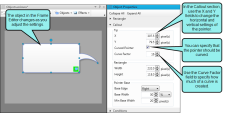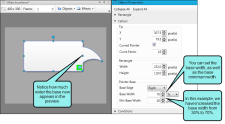The pointer portion of a bubble callout can be curved, and you can adjust the amount of curve used. In addition, you can make changes to the base of the pointer and specify which edge of the bubble shape holds the pointer.
[Menu Proxy — Headings — Online — Depth3 ]
How to Adjust the Pointer on a Bubble Shape
- Open a frame that has a bubble shape added to it.
- Double-click the bubble shape. The Object Properties window pane opens.
- Expand the Callout section.
-
Make the changes in this section as necessary.
To Add Curve to the Tip
- In the Tip section, click Curved Pointer.
- To adjust the amount of curve, change the number in the Curve Factor field. The higher the number, the greater the curve. You can enter negative numbers too.
- You can change the numbers in the X and Y fields to alter the distance of the pointer horizontally and vertically. You can enter negative numbers too.
To Modify the Edge Position of the Pointer
In the Pointer Base section, click Base Edge field and select the side of the bubble where you want the pointer to be shown (Left, Right, Top, Bottom).
To Modify the Pointer Base
- In the Pointer Base section, change the number in the Base Width field. The higher the number, the wider the base.
-
To set the minimum width for the base, in the Min Base Width field, enter a number of pixels. This lets you specify the smallest width of the base allowed, in case the bubble is resized.
Example
Let's say you set the "Min Base Width" to 10 pixels and you set the "Base Width" to 30%. In this case, the base will be 30% of the bubble width at all times, unless the bubble is resized so much that the base would fall below 10 pixels. If that were to happen, the 10-pixel threshold would kick in and the 30% specification would be ignored.
- Click
 to save your work.
to save your work.
Example
Example
When you first draw a bubble shape, it might look something like this:

After clicking on the shape, the Object Properties window pane opens. You can expand the Callout section and make the necessary changes in the Pointer Base section.
Now let's say you want to change the width of the pointer base. In that case, simply adjust the Base Width and/or Min Base Width fields.
What’s Noteworthy?
Note A very useful tool when working with objects is a palette, which lets you store objects for future use. For example, if you are including callouts with some
What’s Next?
If necessary, you can continue enhancing the movie. Otherwise, you can finalize the movie by building and distributing it. See Editing a Movie and Building Movie Output Using the Interface.


